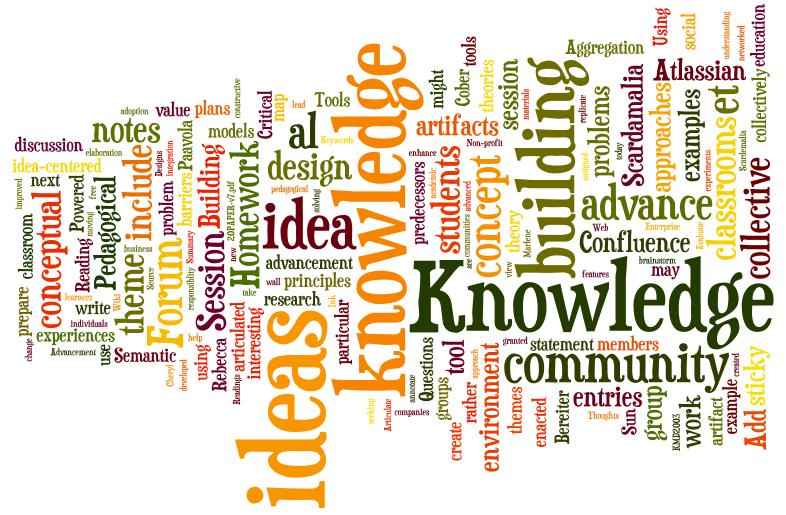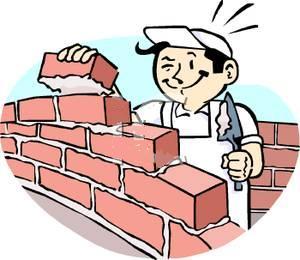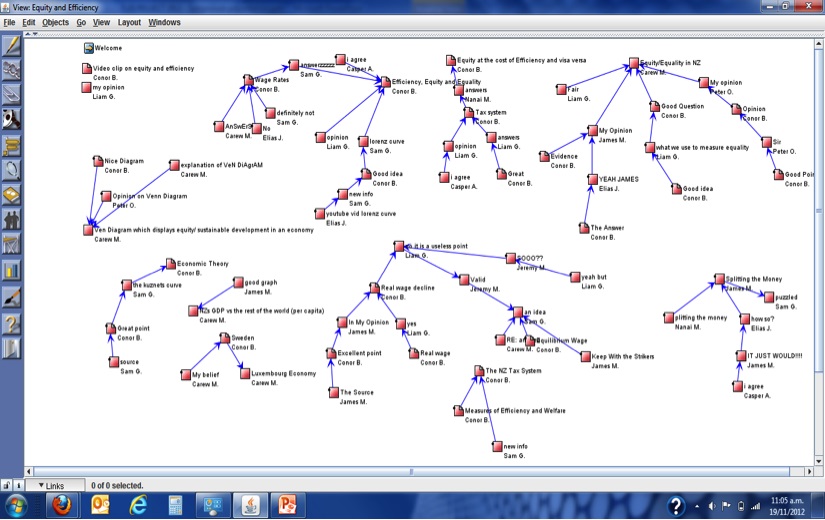Knowledge Building
A scenario
If we put inquiry-based learning and collaborative learning together, we may get something closer to knowledge building. It is a kind of inquiry-based collaborative learning, emphasizing on taking collective cognitive responsibility for creating new knowledge for their community. It may sound a little bit abstract here. Lets look at a metaphor bellow to understand more about it.
A basic theoretical assumption in knowledge building is that knowledge is socially constructed. What do we mean by socially constructed? You must know how people build walls. Pieces of bricks are built on each other to make the wall higher and higher, and then the whole construction is created. It is the same with our knowledge enterprise; it is built by different peoples ideas. One idea builds on the others to make the knowledge wall higher and higher.
Figure 1. Builders build concrete wall
SourceFigure 2.
Knowledge builders build abstract knowledge wall on knowledge forumThis is just a simplified metaphor used here to describe how knowledge is socially constructed, and how different ideas can be put together to create something new. The real construction process is not as simple as sticking all the pieces of bricks (ideas) together. In order to facilitate students deep knowledge construction process, Knowledge building people created a computer supported platform called Knowledge Forum, where students work like knowledge builders [See picture 2], building on each others ideas to construct the abstract knowledge wall of their community. The concrete building is made by putting thousands of bricks together; however, the knowledge enterprise is not simply made by putting all the pieces of ideas together. In knowledge building, ideas may interact with each other, they may be revised, synthesized, and improved. The owners of the ideas (learners) need to actively work on these ideas and take responsibility to improve them.
That is the main concept of knowledge building, then how is knowledge building operationalized in the real classroom? How can we transform our students into knowledge builder? Lets look at a knowledge building scenario here.
Maria is a science teacher. For each topic she teaches, she always lets students brain storm all the real life events related to the topic, and then inspire them to raise questions they want to know. The ones that interest the whole class are moved to the knowledge forum for further inquiry. On the knowledge forum, students can develop explanations to answer their classmates questions. Later these explanations are further improved by the whole class through continual questioning, clarification, and developing. Students also search authoritative information online to find out more about the topic, and use that as a base to push the knowledge of their class forward. Sometimes different students have different explanations for certain question, they also design and do experiment to test their ideas. Maria suggests that when you work on it, you will be amazed by what students can do, and how they can work on the cutting edge of knowledge and create something new.
Definition
Knowledge building represents an attempt to rebuild our classroom in a fundamental way, in which students
-
work collectively to investigate questions and knowledge problems and advance them through collective efforts of community
-
create knowledge which may not new to the world, but has been recognized as the contributions to the advancement of the community and an enabling effect on future knowledge creation
The emphasis is on progress toward collective goals of understanding, rather than individual learning and performance.

Figure 1. Worlde of Knowledge Building. [Source]
Basic Assumptions and Principles
Scardamalia (2002) articulated a system of twelve knowledge building principles as follows:
1. Real Ideas, Authentic Problems
Knowledge problems arise from efforts to understand the world. Ideas produced or appropriated are as real as things touched and felt.
2. Improvable Idea
Participants work continuously to improve the quality, coherence, and utility of ideas. For such work to prosper, the culture must be one that people feel safe in taking risks- revealing ignorance, voicing half-baked notions, giving and receiving criticism.
3. Idea Diversity
To understand an idea is to understand the ideas that surround it, including those that stand in contrast to it creating a rich environment for ideas to evolve into new and more refined forms.
4. Epistemic Agency
Participants set forth their ideas and negotiate a fit between personal ideas and ideas of others, using contrasts to spark and sustain knowledge advancement rather than depending on others to chart that course for them. They deal with problems of goals, motivation, evaluation, and long-range planning that are normally left to teachers or managers.
5. Community Knowledge, Collective Responsibility
Contributions to shared, top-level goals of the organization are prized and rewarded as much as individual achievements. Team members produce ideas of value to others and share responsibility for the overall advancement of knowledge in the community.
6. Democratizing Knowledge
All participants are legitimate contributors to the shared goals of the community. The diversity and divisional differences represented in any organization do not lead to separations along knowledge have/have-not or innovator/non-innovator lines. All are empowered to engage in knowledge innovation.
7. Symmetric Knowledge Advance
Expertise is distributed within and between communities. Symmetry in knowledge advancement results from knowledge exchange and from the fact that to give knowledge is to get knowledge.
8. Pervasive Knowledge Building
Knowledge building is not confined to particular occasions or subjects but pervades mental life – in an out of school.
9. Constructive Uses of Authoritative Sources
To be in touch with the present state and growing edge of knowledge in the field. This requires respect and understanding of authoritative sources, combined with a critical stance toward them.
10. Knowledge building discourse
The knowledge itself is refined and transformed through the discursive practices of the community – practices that have the advancement of knowledge as their explicit goal.
11. Embedded, Concurrent and Transformative Assessment
Assessment is part of the effort to advance knowledge it is used to identify problems as the work proceeds and is embedded in the day-to-day workings of the organization. The community engages in its own internal assessment.
12. Rise Above
Creative knowledge building entails higher-level formulations of problems, working with diversity, complexity and messiness out of that achieve new syntheses. By moving to higher planes of understanding knowledge builders transcend trivialities and oversimplifications and move beyond current best practices.
Primary Theorists
|
Figure 1. Carl Bereiter |
Figure 2. Marlene Scardamalia |
The model of knowledge building was created and developed by Carl Bereiter and Marlene Scardamalia for describing what a community of learners needs to accomplish in order to create knowledge since the 1980s.
Classroom Implication and Teaching Strategies
Principle-based approach
First of all, Scardamalia and Bereiter advocated the importance of a principle-based approach rather than one that focuses on procedures, routines, and sequences of activities. Pedagogy and technology design should align with the theoretical foundation of the model.
Knowledge Forum
In order to realize these principles, a Knowledge Forum environment was developed by Scardamalia and Bereiter (1994) to provide a workspace in which the main work of a knowledge building group would take place, including
- read through the knowledge base
- add text, graphics, questions
- link to other notes
- comment on each other’s work
- search existing notes
- organize notes into more complex structures
Generally, Knowledge Forum is designed to help students to refine, reframe, and advance ideas and engage in such a process of idea improvement.
The main constituents of a Knowledge Forum database are notes and views.
- A view is an organizing background that visually adds structure and meaning to the notes whose icons appear in it, such as a concept map, a diagram, or a scene.
- Notes are contributed to views and may be moved about to create organization within views A note may be thought of as the embodiment of a single idea.
In addition, Knowledge Forum technology includes analytic tools and assessment tools, including analytic toolkit and java-based Applet tools for analyzing contribution, interaction and connectedness, which are premised on the principle of concurrent, embedded and transformative assessment.
However, students using Knowledge Forum do not spend all their time at the computer. They can do all the other things that make up a rich educational experience:
- read books and magazines
- have small-group and whole-class discussions
- design and carry out experiments
- build things
- go on field trips, and.
Pedagogical and Technological Scaffolds
Scaffolds are provided to give the note a role in more extended work with ideas such as theory refinement, evidence gathering, argumentation, literary interpretation, and so forth.
For instance, the scaffolds guide students in constructing their notes through features such as a set of theory-building scaffolds that include
- My theory,
- New information
- This theory explains
- This theory cannot explain
Resources
- The Cambridge handbook of the learning sciences
- Scardamalia, M. & Bereiter, C. (2006). Knowledge building: Theory, pedagogy, and technology. In R. K. Sawyer (ed.), The Cambridge handbook of the learning sciences (pp. 97-118), Cambridge, MA: Cambridge University Press.
- NAPLeS Webinar Series by Jim Slotta: Knowledge Building and communities of learners
- Presentation Slides: Knowledge Community and Inquiry
- Slotta, J.D. Knowledge Community and Inquiry: New Opportunities for Scripting and Orchestration. [Online]
- Stahl, G. (2000). Collaborative information environments to support knowledge construction by communities. AI & Society, 14, 1-27. [Online]
- Zhang, J., Hong, H.-Y., Scardamalia, M., Teo, C., & Morley, E. 2011. Sustaining knowledge building as a principle-based innovation at an elementary school. Journal of the Learning Sciences, 20, 262-307. [Online]
- Chan, C. K. K. (2011). Bridging research and practice: Implementing and sustaining knowledge building in Hong Kong classrooms. International Journal of Computer-Supported Collaborative Learning, 6(2), 147-186. doi: 10.1007/s11412-011-9121-0
- Scardamalia, M., & Bereiter, C. (1996). Computer Support for Knowledge-Building Communities. In T. Koschmann (Ed.), CSCL: Theory and practice of an emerging paradigm (pp. 249-268). Mahwah, NJ: Erlbaum.
- Van Aalst, J. (2009). Distinguishing knowledge-sharing, knowledge-construction, and knowledge-creation discourses. International Journal of Computer-Supported Collaborative Learning, 4(3), 259-287. doi: 10.1007/s11412-009-9069-5
- 《中文科課程新嘗試──高思維能力的教學實踐》



